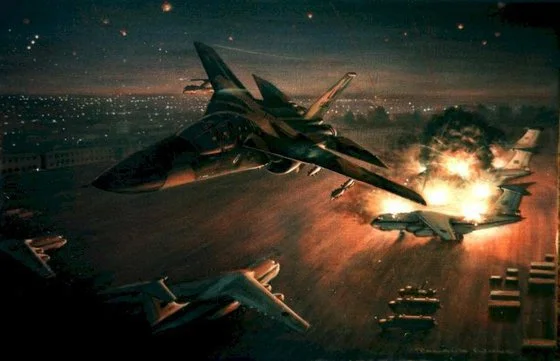Although seismic shifts—revolutions—dot history, we cannot forget history’s continuities in warfare. Such are the ways to think about the future as it slips into history. This delightful, insightful book will greatly aid our perspective of that future.
A Pyongyang Spring? Not So Fast
Whilst the diplomatic de-escalation of tensions in early 2018 is a welcome affirmation of Churchill’s observation that ‘jaw jaw is better than war war,’ the apparent concessions that North Korea has offered are not particularly damaging to Pyongyang’s interests. The array of concessions that Kim Jong Un has offered do not meet the standard of costly signals. North Korea has, on multiple occasions, offered concessions to U.S. and South Korean interests, only to renege on them with embarrassing haste. It is thus necessary to go beyond a superficial reading of DPRK’s apparent concessions.
Syria: The Dangers of the Chosen Path
Judging from recent comments, the path the U.S. seems to be on—and it’s not a path all of our European allies and regional partners share—is withdrawal from Syria except for the occasional airstrike if Assad again uses chemical weapons. This path is not good. Withdrawal would yield the area to already expanding Russian and Iranian influence. Most likely, an American withdrawal would not help reduce ISIS capacities, nor would it reduce the capacities of al Qaeda and other radical jihadist organizations. The American withdrawal and the establishment of this Russian arc of influence will move Turkey, a key NATO ally, further towards Russia; put more pressure on Israel and Jordan; and push Iraq even closer to Iran. Withdrawal also abandons our Kurdish partners, or at least puts them in a more difficult position. And withdrawal further reduces America’s trustworthiness as an international leader. Finally, U.S. withdrawal de facto rewards Assad’s brutal and ruthless behavior toward the citizens of Syria. But the U.S. does have an alternative path.
Who’s Missing? The Limits of Professional Reading Lists
A reading list, quite obviously, is a list of readings; it is a list defined by its content. But a professional reading list is actually more than a list of professional readings. It prescribes its own use: Wrestle with me, it goads. Debate me. Engage. At the very least expect an encounter. The texts listed within serve to further circumscribe the profession and those within it, as professionals. Martha Nussbaum in Not for Profit: Why Democracy Needs the Humanities explains “When people see their ideas as their own responsibility, they are more likely, too, to see their deeds as their own responsibility.” Just as we seek to instill decentralized execution in tactical engagements, introducing critical thinking serves to empower junior leaders to take ownership of their ideas; the list is not a checklist, but a playlist, a library of potential.
#Reviewing Taliban Narratives
Taliban Narratives, by Professor Thomas Johnson, explores Taliban and U.S. communication cultures by analyzing narratives, propaganda, and stories between 2001-2011. Johnson decodes the Taliban’s master narrative, information operations, target audience, and their propaganda tools such as circulars, shabnamahs (night letters), internet accounts, graffiti, poetry, and chants, which he refers to as cultural artifacts. He argues the Taliban, unlike the U.S. and coalition forces in Afghanistan, have culturally relevant information closer to the values held by the local population. Aiming at changing the emotions and perception of people, Taliban campaigns target rural Afghans by focusing on local issues.
#Reviewing Taliban Narratives
Students of the Afghan conflict, information operations officers, public affairs professionals, diplomats, relief workers, and those working in the intelligence and psychological operations arenas would all be well served to have this reference close at hand. One can only hope the failures Johnson cites are not repeated, and, if the war cannot be won by the West, perhaps this book can help the Afghans find an honorable and enduring conclusion.
Innovation Determinants of the World’s First Integrated Air Defense System
Despite having the strongest air force in the world at the conclusion of the First World War, Britain faced a prominent strategic threat posed by a sizable French bomber force and the creation of the Luftwaffe, the German Air Force. To counter the threat, the British created the world’s first integrated air defense system—a synchronized nexus comprised of radar to detect enemy aircraft, a command and control network to relay warnings, and fighter aircraft to challenge threats.
War in a Box: Strategic Planning Using Integrated Semiotic Squares
Freedom: The God of Modern War?
#Reviewing The Unknowns: The Untold Story of America’s Unknown Soldier and WWI’s Most Decorated Heroes Who Brought Him Home
The Unknowns is a great book on the topic that surrounds the Tomb of the Unknown Soldier from the First World War. It’s also a good single volume work on the American Expeditionary Force’s involvement and experiences in the First World War. This book will resonate in military affairs and veteran organization. Finally, this book is a great read for anyone interested in the United States Marine Corps involvement in the First World War.
America’s Conflicted Approach to the World: #Reviewing The Sovereignty Wars
Terms that endure tend to grow more capacious over time; if they do not adapt to evolving political realities, social norms, and technological forces, after all, they risk fading into obsolescence. To the extent that they become part of a widely shared vocabulary, they can facilitate communication. Unfortunately, though, they can also become victims of their own success: a term can become sufficiently elastic that its usage comes to obscure more than clarify; worse, it can be consciously misappropriated.
Were the French Really Doomed to Defeat in 1940?
Success will not only be a matter of mere military adaptability, but above all the result of a political, popular, and military convergence, especially if reserves or conscripts are to be used as force multipliers. Therefore, officers should develop a political understanding of their profession within society.
Rivalry in Rejuvenation? Seeking New Paradigms for U.S.-China Strategic Competition
The U.S.-China relationship may shape the course of this century, and its future trajectory remains highly uncertain and contentious. Persistently, U.S. strategy has struggled to characterize and formulate a framework for America’s relationship with the People’s Republic of China (PRC). Today, as the U.S. and China dance on the precipice of a trade war, there is talk of a new Cold War in which the U.S. confronts a rival that is unique as not only a near-peer military competitor but also a rising economic and technological powerhouse.
#Reviewing Does My Suicide Vest Make Me Look Fat?
Ready offers a necessary antidote to the lionization of American military service, as well as an honest picture of the challenges of coming home to normal life. This is a book that will speak to anyone who’s worked in a large, complex bureaucracy, anyone who had to explain to their guys that they were taking an ‘operational pause’ because somebody forgot to pack enough batteries, and anyone who’s had a useless boss in any job, not just the military.
#Reviewing Ways of War: American Military History from the Colonial Era to the Twenty-First Century
Overall, Ways of War provides a solid history of the military and warfare in the United States from the colonial era to the present. It is not without its shortcomings, though considering its objectives as a textbook for survey classes, needing to provide enough information for students to become knowledgeable in the field while also not losing them in the details and keeping the amount of material manageable for the time constraints of a course, it accomplishes a lot
Bombers over Tokyo: The Strategic Importance of Doolittle’s Raid
Despite the long odds, Doolittle’s Raiders slipped through Japan’s defenses on April 18, 1942 to deliver a surprise blow. The raiders bombed several Japanese cities including Kobe and Yokohama, but Tokyo was perhaps the most significant because it was the Emperor’s home and the nation’s capital. In stunning fashion, the raid answered President Roosevelt’s call for retaliation and soothed America’s wounded pride. The Doolittle Raid’s place among the time-honored traditions of courageous military action is secure, but its impact on America’s ultimate victory in the Pacific remains unclear.
Innovation and the Challenger Mentality
#Reviewing The Direction of War & Strategy: Context and Adaptation
#Reviewing Hubris: The Tragedy of War in the Twentieth Century
In Hubris: The Tragedy of War in the Twentieth Century, British historian Alistair Horne ties together five key battles in the first part of the twentieth century with one word—hubris. Horne focuses on “those conflicts that have affected future history powerfully in ways that transcended the actual war in which the conflict was set.” This is the last book Horne published before passing away in 2017, Hubris is the final word by a writer who spent more sixty years writing about modern warfare, a fitting epitaph for warfare in the twentieth century.
Punishment or Provocation? Echoes from El Dorado Canyon
In terms of lessons, Operation El Dorado Canyon is rich, and oft-neglected by modern strategists. The mission’s planning and execution have filled several books; however, it is with the renewed interest in the idea of ad hoc, limited, retaliatory strikes, that this operation becomes particularly instructive.





















